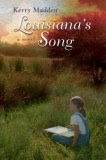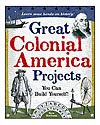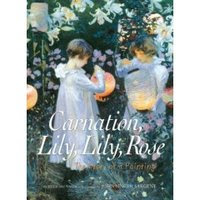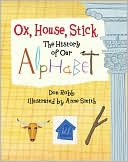new posts in all blogs
Viewing: Blog Posts Tagged with: louisianas song, Most Recent at Top [Help]
Results 1 - 5 of 5
How to use this Page
You are viewing the most recent posts tagged with the words: louisianas song in the JacketFlap blog reader. What is a tag? Think of a tag as a keyword or category label. Tags can both help you find posts on JacketFlap.com as well as provide an easy way for you to "remember" and classify posts for later recall. Try adding a tag yourself by clicking "Add a tag" below a post's header. Scroll down through the list of Recent Posts in the left column and click on a post title that sounds interesting. You can view all posts from a specific blog by clicking the Blog name in the right column, or you can click a 'More Posts from this Blog' link in any individual post.
 Louisiana's Song by Kerry Madden
Louisiana's Song by Kerry Madden
Reading level: Ages 9-12
Hardcover: 256 pages
Publisher: Viking Juvenile (May 17, 2007)
ISBN-10: 0670061530
ISBN-13: 978-0670061532
Source of book: Bought it
Louisiana's Song , the second book in the Maggie Valley trilogy takes place a few months after Daddy's accident that occurred in Gentle's Holler (my review here). Daddy's back home, but the brain injury has left him with amnesia and short-term memory loss. He can't play his banjo and can't keep the names of all of the children straight. As the narrator, Livy Two, struggles with the fact that the father she knew and loved is "lost," her super shy sister Louisiana, or Louise, struggles with a growth-spurt that has left her very tall and the target of the school bully's jokes. But Louise has a special talent at art that the stern school teacher, Mr. Pickle, realizes and encourages her to develop. With Daddy unable to work and money tighter than ever, the family continues to struggle to make ends meet, and if things don't look better soon, they may have to move out of their beloved Maggie Valley and move into Grandma Horace's house in "Enka-Stinka."
In Louisiana's Song , Kerry Madden delves deeper into the characters, and I enjoyed learning more about some of the Weems' siblings. Through older sister Becksie's campaign to be "Maggie Queen," it is evident that she is desperately trying to be "normal" and to fit in with the other kids despite her family's extreme poverty. It's the same with Emmett who tries to impress his family with stories about how he's a gunslinger at "Ghost Town in the Sky," the attraction where he now works. While Louisiana is an exceptional artist, she is extremely shy and mostly wants to keep to herself. We also see the twins' Cyrus and Caroline's personality start to come out. We also see Livy Two start to grow up as she deals with all of the upheaval in her life.
While the family's situation is serious and there are sad moments, Kerry Madden does a great job of weaving in humor and demonstrating the love between the family members as she did in Gentle's Holler. For example, Daddy's brain injury is heartbreaking and not a laughing matter, but there are times when he says and does funny things. Once he wanders off to town in his bathroom and ends up at the pancake house. When Livy Two and her Mama find them, Daddy is happy to see them and offers Livy Two some pancakes:
"'Hungry?' He pushes his plate toward me, and I take a bite of his mountain blackberry pancakes swimming in maple syrup. Pure heaven on earth.
When I take a second bit, he says, 'Give it back now.'
'Okay, Daddy.' I push his plate of pancakes back toward him, and he keeps eating like a house on fire." (pp. 101-102).
When you read
Louisiana's Song, you'll laugh and you'll cry. You'll want to listen to mountain music that will take you back to Maggie Valley. But overall, you'll care about the Weems family and truly hope that things will get better for them. This family will stick with me for a long time.
What Other Blogger's Are Saying: Shelf Elf: "
Louisiana’s Song is one beautiful book." (
read more...)

My mother, Alice Herold, served on the Non Fiction (Middle Grade/Young Adult) judging panel for the Cybils. She also reviews books for this site and The Edge of the Forest. Today, for Non Fiction Monday, I bring you her capsule reviews of four of the Cybils shortlisted titles. I'll post the other three next week.
Reviews by Alice Herold
 The Periodic Table: Elements with Style
The Periodic Table: Elements with Style
by Adrian Dingle, illustrated by Simon Basher
The Periodic Table: Elements with Style [Editorial interruption: That's one cool title!] is a completely original book about the 111 known elements. Dingle and Basher bring the elements to life, presenting them as cartoon characters and giving them a first-person voice. Radium looks like a newborn--a smiling baby boy encased in an oval shape, sound asleep. Helium is a pink balloon with a zen-like expression who says, "I am a noble gas with no color, taste, and smell. My main uses are in weather balloons and airships which need lighter than air properties." Dingle and Basher also include detailed information about each element--symbol, color, weight, density, standard state, classification, melting point, etc. The Periodic Table: Elements of Style also includes a helpful glossary and a colorful poster.

Tracking Trash: Flotsam, Jetsam, and Science of Ocean Motion
by Loree Griffin Burns
Did you know there is a floating garbage dump between Hawaii and California as big as Alaska? It lies in a convergence zone where currents come together and force the surface waters to sink. Did you know that 100,000 marine mammals in the Pacific Ocean die each year due to plastic ingestion? There is an underlying Save the Oceans theme in Tracking Trash, but Burns presents it in a way that leads the reader to think about the causes of pollution, rather than the effects. A glossary, a booklist, and a website resource list are included in the appendices. (I also learned that OSCURS--Ocean Surface Current Simulator--can tell you where and when lost cargo will wash ashore if you input a date and specific ocean location [longitude and latitude] where the cargo was lost.)
 Smart-Opedia: The Amazing Book About Everything
Smart-Opedia: The Amazing Book About Everything
by Eve Drobot, ed.
Smart-Opedia: The Amazing Book About Everything is my solution to increasing my Jeopardy! score. Ten writers and eighteen authors are behind this ambitious book that covers a range of information about, well, everything. The authors have included additional features as well for each topic, including "Career Opportunities," "Timelines," "Spotlight," "Kids' Questions," "Answers," and "Number Crunch" among others. One of my favorite features is "Tune-In" which offers a more in-depth look at a certain subject. This informational and fun-to-read "encyclopedia" makes a wonderful gift for a child eight years and older.

Who Was First?: Discovering the Americas
by Russell Freedman
Who Was First?: Discovering the Americas reads like a mystery. First Freedman debunks the assumption--Columbus discovered America in 1492--and then moves on to other, more compelling evidence: 1) Archaeologists in the 1970s discovered tools and the remains of ancient fire pits near Pittsburgh dating back 18, 000 years; 2) A 13, 500-year-old spearhead was found in 1933 next to a skeleton of a woolly mammoth in New Mexico; 3) Leif Erikson and crew established the first European settlement on North America around 1, 000 A.D. on the Northern tip of Newfoundland; and 4) There is a tower in Newport, Rhode Island that may date back to 1405-1433 when a mighty Chinese Armada set sail with 250 ships and perhaps 28, 000 crew members. Who Was First? is a fascinating and well-researched journey.
Up next week: Mom's reviews of Marie Curie, by Kathleen Krull, The Wall, by Peter Sis, and a longer review of the winning Non Fiction (MG/YA) title, Tasting the Sky, by Ibtisam Barakat.

By:
Kelly Herold,
on 2/18/2008
Blog:
Crossover
(
Login to Add to MyJacketFlap)
JacketFlap tags:
non fiction Monday,
middle grade non fiction,
Build It Yourself,
Kris Bordessa,
Carmella Van Vleet,
Build It Yourself,
Carmella Van Vleet,
book review,
Kris Bordessa,
middle grade non fiction,
non fiction Monday,
Add a tag

The Do-It-Yourself bug starts early in some children. Certain projects have enduring appeal, like the old paint-your-own-room-with-markers job, or the build-an-igloo-out-of-wet-toilet-paper activity. But, maybe, just maybe, you as a guardian might prefer to channel the creative activity of your youngsters--and give them a little learning in the process to boot. So, if you have a crafty child in your home, classroom, or library, then I highly recommend Nomad Press's Build It Yourself Series.
I read Great Ancient Egypt Projects You can Build Yourself, by Carmella Van Vleet, and Great Colonial America Projects You Can Build Yourself, by Kris Bordessa. Both books follow a similar structure: They are organized around historical themes (Egypt--"Foundations of "Ancient Egypt," "Boats," "Hieroglyphs"; Colonial America--"The First Americans," "Life in a Colonial Home," "Colonial Farms and Gardens") and each chapter contains historical information and a few projects of varying complexity. Take, for example, Bordessa's chapter on "Life in a Colonial Home." In this chapter, projects include building your own model Wattle-and-Daub house, creating your own bricks, making straw ticking for a bed, making candles and candle holders, creating your own silhouette and braided rug, and making your own broom. There's something for everyone!

The Build It Yourself books also feature a number of games and toys a child can build, as well as information on the history of the toys and games and how to play them. The volumes also include brief asides on important historical figures, manners of the age, and on language. The Build It Yourself books are best suited for children ages 8 to 12 (third through sixth grades).
Now, get busy!
-------------------
Personal note: PJ Hoover! There's a make-your-own papyrus section in Great Ancient Egypt Projects.
------------------
Anastasia Suen hosts the Non Fiction Monday roundups at Picture Book of the Day.

Today Non Fiction Monday meets Wicked Cool Overlooked Books!
In thinking over 2007 and the Non Fiction books I think have been overlooked, Hugh Brewster's Carnation, Lily, Lily, Rose was the first title to come to mind. (Here's my review.) Why? Well, most obviously, because it was the Non Fiction title I appreciated most in 2007. Second, I found Brewster's blending of the fictionalized (the fictional narrative of Kate, based on the very real Kate's diaries and letters) and the real (the story of John Singer Sargent's composition of Carnation, Lily, Lily, Rose) to be a masterful example of compelling Non Fiction for Middle Grade readers. And, third? Carnation, Lily, Lily, Rose features John Singer Sargent's unabashedly romantic paintings as illustrations, along with photographs of real objects from the same period. Published by Kids Can Press, the production value of Carnation, Lily, Lily, Rose is high. Please, don't miss this one.
Carnation, Lily, Lily, Rose was reviewed in the Washington Post and the Christian Science Monitor, but not on the blogs. (I found one--count 'em, one blog review besides my own--at Fiske Miles's blog.)
-----------------
A big welcome to the authors blogging at I.N.K. (Interesting Nonfiction for Kids)!

Anastasia Suen has instituted Non Fiction Mondays on the children's literature blogs: it's the hard-working Monday to the frivolity of Poetry Friday! Join in, won't you?
Today for Non Fiction Monday I bring you a review of a book my mother read and enjoyed greatly.
This review was written by Alice Herold.
Ox, House, Stick: The History of Our Alphabet, by Don Robb, illustrated by Anne Smith

Scientists interested in the history of languages have traced our alphabet back about 4, 000 years. Ox, House, Stick tells the origin of some of the letters. I was surprised that A was named for an ox in the early Sinaitic alphabet. Turn it upside down and it shows the horns of an ox. Anne Smith contributes helpful pictures on the sides of each page of Ox, House, Stick showing what the letter looked like in Sinaitic, Phoenician, Early Greek, Classical Greek, and Roman Latin.
Robb explains that scientists are fairly certain that our D began as the Phoenician letter daleth meaning door. M in its original Sinaitic form means water. O, P, R, and S came from words for part of the head.
I found it interesting that Greeks wrote in both directions--called "boustrophedon"--which means "as the ox plows," turning at the end of the row to go back the other way.
The Romans became tired of reading words without spaces between them so they began to put a dot between sentences. The dot later became the punctuation mark we call a period.
Ox, House, Stick is an educational, fascinating book especially since I read it one day after visiting the Dead Sea Scrolls exhibition. Robb includes lists of websites and additional resources at the end of the book.
 Louisiana's Song by Kerry Madden
Louisiana's Song by Kerry Madden






I hate to be a nit-picker, but I think it's Elements with Style, not "of". Sounds like a cool book!
Dear Nitpicking Anon: Thank you very much! Fixed.
Alice was a pleasure to have on the committee. Glad to see her well-informed thoughts getting exposure here.
I love Tracking Trash! Will have to check out the other ones as well.
I was just looking for some good non fiction on amazon. Thanks for the post.
Totally of topic but the new Laura Lippman comes out Mar 11, and is Tess is back. Sweet
Doret
Doret: Yahoo! Thanks for the tip. Sweet is right!!
Laura: There are some good ones on this list. Enjoy!
Thanks, Jen :)